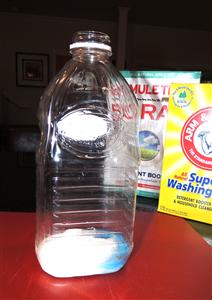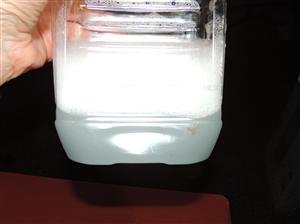It seems as though the big news going around the prepping and DIY community is how to make your own laundry detergent. As a matter of fact, enter “DIY Laundry Detergent” in your search engine and you will come up with more than 1.8 million hits. As you start to click through the links, you will find dozens of variations on the recipe.
Well I am here to tell you that you can forget about grating bars of soap. In addition, you can forget about making up 5 gallon buckets filled with detergent and you can forget about cooking up a laundry detergent stew in a big kettle on the stove.
Who has time for that craziness? I sure don’t.
The Basic Recipe for Laundry Detergent
Before I launch into the recipe, I want to say a word about the ingredients.

With no apologies, the ingredients, while inexpensive, may or may not be considered “green”. As a matter of fact, there is a bit of an online war as to whether one particular ingredient, borax, is safe and environmentally friendly. The last thing I want to do is get in the middle if that argument so let us put those considerations aside for now and get on with the basic recipe.
3 tablespoons Borax (such as Twenty Mule Team)
3 tablespoons Washing Soda (such as Arm & Hammer)
2 tablespoons Liquid Dish Soap (such as Dawn)
8 cups water – preferably filtered
Directions:Find yourself a 1/2 gallon container such as a clean juice bottle that has been repurposed. Get out a funnel and add the borax and washing soda followed by 2 cups of boiling water. Give it all a good shake until the powdered ingredients are dissolved.Add the liquid dish soap and swish it around until the brew is well mixed.Once that is done, add the remaining water which will pretty much fill the jug. Do not be surprised if there are bubbles coming out of the top – that is the dish soap doing it’s thing.When it is time to do laundry, measure out 1/4 cup to 1/2 cup of your DIY laundry detergent and wash normally. This detergent will be thin and watery but don’t worry, it will work just fine.
See what I mean by no muss no fuss? Depending on how much you use per load, this will produce enough laundry detergent for 16 to 32 loads of laundry and, if you are so inclined, can easily be doubled to produce a full gallon.



How Clean is Clean?
All of the successful tests using my homemade laundry detergent were done with cold water and without additives such laundry boosters or bleach products. In addition, I did not – and do not – use fabric softeners so that was not a factor.
I pre-treated nasty stains and spots by spraying plain water on the garment and rubbing the stain with a bar of Fels-Naphtha soap. This seemed to work well but I need to keep doing this for awhile before I will know for sure that this is a workable solution for spot cleaning.
Speaking of spot cleaning, I have tried three different recipes for “homemade Shout” and all were a waste of time. None of them worked at all and my clothes had to be re-laundered using Zout stain remover (which I prefer over Shout). Of course this was before I tried Fels-Naphtha which does seem to work. For those of you that are interested, my homemade Shout was made using various combinations of dish soap, ammonia, baking soda and water.
Now by way of full disclosure, we have pretty soft water where I live which helps a lot. This is probably why I do not need fabric softeners although I am told that a quarter cup of vinegar will work as a decent fabric softener. I tried it but there was not enough of a difference to notice but again, that may be due to the water.
On the other hand, and this is important – some of my trials using a powdered version of DIY laundry detergent left mystery stains on my whites. To get these grayish, greasy looking spots out, I had to re-wash my stuff four times in hot water and bleach. Nothing else would remove them.
So what were these spots and where did they come from?
As it turns out, the spots are residue from un-dissolved borax settling on my clothes during the wash cycle. I have an HE type washer and the laundry detergent is dispensed automatically via a dispenser go my best guess is that the combination of low water and low water temperature were insufficient to dissolve the powder. So be aware and do not be surprised if this happens to you.
Dish Soap versus Castile Soap
Okay, let me be truthful. Dish soap is really a detergent and not a soap. What is the difference?
In simplistic terms, soaps are made from natural fats and oils while detergents are made with some natural but mostly synthetic chemicals. A hugely popular soap these days is Dr. Bronner’s Magic Soap which is a castile soap that is made from organic coconut and olive oils among other things.
which is a castile soap that is made from organic coconut and olive oils among other things.
I have my opinion about this soap – which is not cheap by the way – but would like to reserve that opinion for another time (it is not all good and not all bad). I will tell you this: if you use it in your homemade, DIY laundry soap, you will be disappointed.
On the other hand, dish soap, such as my beloved Dawn, is made from chemicals. While this might not be considered very green, I would personally rather have clean clothes than a load of dingy stained items that require washing two of three times before coming clean. With the wasted water and electricity, how green is that?
At the end of the day, however, you need to decide what works for you. All I can do is share my experience and my opinions. That said, I have been experimenting and testing DIY cleaning products for quite a while and stand by my recommendations.
What About the Cost
I had to get out the calculator and the scale for this one. I paid $4.89 for 76 ounces of borax and $3.55 for 55 ounces of washing soda and $5.64 for the Dawn dish soap. Given the minute amounts of each ingredient, I came up with 23 cents per half-gallon batch or less than 1 1/2 cents per load using a full half cup per load.
Now that is cheap. As a comparison, the laundry detergent I purchase at Costco runs about 11.7 cents per load. Still, I have a hint for you. You can use 1/2 the recommended amount of commercial laundry detergent and chances are you clothes will come out clean. That brings the cost down to a manageable 5 or 6 cents per load and that’s not bad. Use only cold water and you will save even more money.
As far as the Fels-Naphtha, I paid $1.79 for a large bar. I probably overpaid because I purchased it locally and later learned that a more typical price is $1.29 per bar. Live and learn. On the other hand, it will probably last forever if I am just using it as a spot and stain remover.
Don’t get ripped off!
You will notice that I did not include any purchase links for the DIY laundry detergent ingredients mentioned in today’s article (borax, washing soda, fels-naphtha and Dawn). That is because you will pay double or even triple from some of the online vendors. Don’t do it. In my case, the borax and fels-naphtha were available locally but I paid a premium. Try to wait until you make a trip to town and find yourself a Walmart. They seem to have the best prices I have seen on laundry items. Naturally, your mileage may vary.
The Final Word
Now in all fairness, I must explain that I have a small household – two adults – and I only do 3 or 4 loads of laundry a week. That means that even if I used packaged detergent from the supermarket or Costco, my cost is not huge. Given that, I still wanted to give the DIY version a try and now I am stuck on it. As far as I am concerned, the packages of borax and washing soda will last me for years and I have already stockpiled a goodly amount of dish soap.
Perhaps over and above all of that, however, it just feels darn good to make it myself!







